Articles and News
What’s The Next Big Thing For Luxury Jewelry? | July 31, 2013 (0 comments)
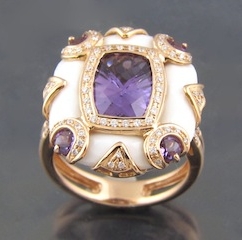
Merrick, NY—Ever since the tennis bracelet, jewelers have been searching for the next tennis bracelet. The Y necklace and the Tin Cup necklace looked promising, but their popularity proved fairly short-lived. Design trends like micropavé and halo settings have more long-term staying power, but will they achieve iconic status?
Apart from design, jewelers also face a host of new challenges in a global, digital, and socially-conscious economy. Millennials are both wired and socially conscious, while jewelers' longtime Boomer customers are aging. Both are changing the landscape for jewelers.
The Centurion set out to see if any trends on the horizon promise to be The Next Big Thing. We polled some of the industry’s leading trend spotters and tastemakers for their observations and predictions of what might be The Next Big Thing. Here’s what they identified:
Severine Ferrari, editor-in-chief of Engagement 101:
- Man-gagement rings. Our latest Engagement 101 survey shows that 70% of men in committed relationships would be open to wearing a ring during the engagement period. Also, we foresee more and more women proposing in the future.
- Couples getting pregnant or having children before getting engaged. Couples now live together before getting engaged, and they get married later than they used to. Mostly it’s for money issues, and also in fear of divorce and failure. In a growing portion of couples, children become the catalyst for the engagement and the wedding.
- More fashion designers licensing or designing jewelry collections following the success of Vera Wang and Monique Lhuillier, for example.
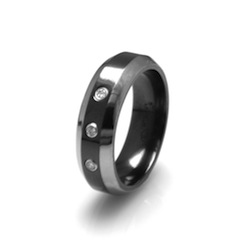
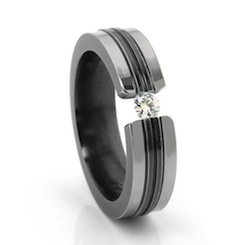
Man-gagement rings from Edward Mirell. Left, 7mm Black Ti ring with beveled edge and 0.9 ct. of diamonds, retail $589; right, 6mm gray titanium ring with Black Ti center and tension-set diamond 0.10 ct.; retail $795.
Amanda Gizzi, director of communications at Jewelers of America:
Fine-jewelry-store-worthy, fashion forward jewelry designs at entry level price points. The distinction between fashion and fine jewelry has become less black and white, and luxury jewelers have a huge opportunity to capitalize on jewelry's popularity by creating and selling fashion-forward jewelry designs that drive new, seasonal customers who crave the hottest jewelry styles into the store (and to purchase online). Let's face it, women love to buy jewelry. They are going to buy jewelry for themselves. Jewelry stores should be that destination!
Below: Chan Luu's pyrite bead wrap bracelet on gray leather retails for $195.
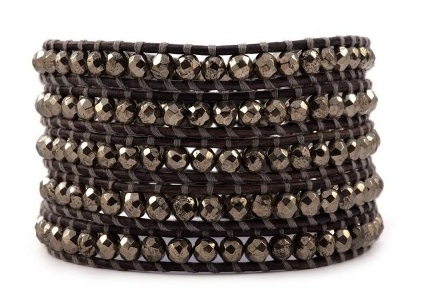
Randi Molofsky, director of marketing and communications for Gemfields and author of A Girl’s Guide To Buying Diamonds:
Without a doubt, transparency is the next big thing in the jewelry industry. Without it, we'll never regain the level of trust and consumer confidence that will allow us to grow and flourish as a luxury category. Buyers these days are highly educated, and they are both aware of and concerned with issues like certification, treatments and sustainability.
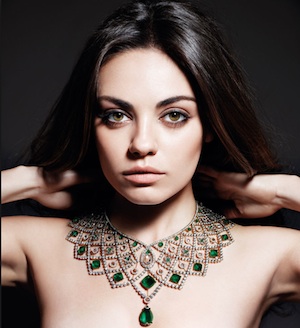
Big, bold, colorful, and ethical: actress Mila Kunis is the brand ambassador for Zambian emerald producer Gemfields. In an interview in Vogue UK, she says she wouldn't sign on until she knew the firm's gems were ethically sourced.
Throughout my time at Gemfields, I've learned that the more we're able to tell our customers about our product, the more invested they become in the brand. We have the power to change the perception that ethics isn’t the jewelry industry’s strong suit—not just because the market is demanding it, but because it will grow and sustain us in the long run.
Laura Brown, luxury product development, branding, and merchandising expert:
From a fashion standpoint, color! Not just in stones but also in metals, and the more unusual the better. The luxury consumer is savvier than ever, has really learned to push her own boundaries, and has moved beyond the standard executions of jewelry.
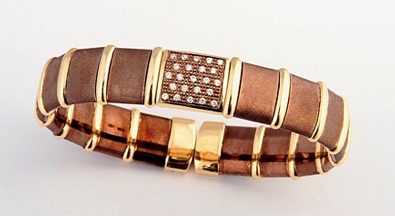
Gold isn't just yellow, white, or rose anymore. It can be brown, blue, purple, or any other color. Bangle, The Henderson Collection.
From a retailer standpoint, offering collections and items with compelling backgrounds, unique details (and having the sales staff who can communicate these) so that the consumer develops a fierce personal attachment. Then she will come back for more. Luxury is finally returning to its roots: special items, not found everywhere, but discovered [by the knowing individual.]
Cindy Edelstein, designer jewelry expert and president of the Jewelers’ Resource Bureau:
I think the next big thing, marketing-wise, is mobile. About 25% of consumers now spend six hours each day on the mobile web, while 7% said they spend more than 12 hours engaging online, according to a global study by Netbiscuits. With smartphones and tablets replacing PCs as the default computing device for many consumers, so, too, is data traffic moving from fixed to wireless networks, says techcrunch.com.

This is the digital norm now, not the exception. Photo: redmondpie.com
Websites that are mobile-ready are a must for all retail jewelers. Even if a store doesn't want to sell online, they need to market online. They need to promote their brands, their trends, their skills, and their personality. Every store has some engaging brands, trends, skills, and personalities, but you have to communicate them! I fear for those who don't even have a good website—or ANY website! It doesn’t seem possible today, but in our research we are constantly stunned to find that about 20-25% of the stores we know exist don’t show up in online searches [because they don’t have a website]!
The mobile trend hits social media, too. Instagram is growing by leaps and bounds and is a great service for sharing images (and now video) from your phone—and only your phone. This is great for jewelry folks who can tell your product’s story instantly in compelling ways, on an app that attracts so many likeminded souls. It’s fun. It’s quick. It’s engaging. And you don't need a computer. And, as of two weeks ago you can embed those Instagram-created videos and pictures on all your other sites, too. So I expect Instagram to grow in prominence due to its ease of use and mobility.
Michael O’Connor, celebrity stylist and fashion commentator, and host of Style File on Reelz TV:
A couple of things have been happening in fashion lately. There’s a real “Retro Revisitation.” I think we’re seeing so much influence in fashion from all decades of the 20th century: Deco-inspired vintage styling, ‘70s flower power and psychedelic colors/prints (including lots of neon), ‘70s colors and ‘80s large proportions. Because we’re seeing a loosening of a tight economy, I think that people will be looking for “power statement” pieces, large pieces with either vintage/structured sensibility, or they’ll be looking toward a more visibly carefree sensibility. I think this will be played out in larger proportioned jewelry overall. Largeness will be provided across the board with precious metals, but I see the continued growth of contemporary metals, along with some mixes to provide contemporary metals a more “established” and precious halo. We’ve already seen lots of colored gemstones enjoy growing popularity; I think this will continue as they offer jewelry the proportion that it will need.
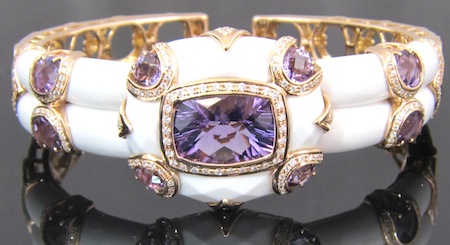
Not shy: Colorful statement pieces are what's trending, says Michael O'Connor. Bangle and ring at the top of the page, Bellarri. Both are faceted white onyx with amethyst in 18k gold.
From a theme perspective, larger jewelry pieces will be either classic mixes of a predominant color (ie. a major stone in a strong color) with supporting/surrounding gems in neutrals or in a new multi-colored (including ombré) look that we’re seeing with South American and Indian designers. It’s a fresh take on color mixes and one that America is not used to seeing – but it’s very exciting.
The Centurion’s own prediction:
Less formality in luxury jewelry. To be fair, edgy isn’t the “next” big thing—the trend has been evident for some time—but we predict it will continue to evolve. Examples include blackened gold, diamond beads, both diamonds and gems used in their rough forms, crafty, hand-worked treatment of metals, gem slices, turning flaws into features; (i.e. using heavily included gem materials that would once have been tossed in the trash), mixed precious and non-precious materials, necklaces worn wrapped as bracelets, and so forth. Look for crafty designs where you almost have to ask if it’s fine or fashion; there’s nothing overtly blingy about it. Only the subtle sparkle of a black diamond and an emerald quickly identifies it to cognoscenti as gem, not glass.
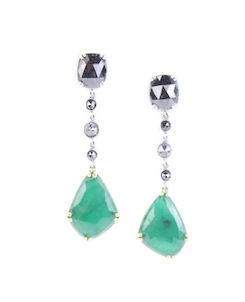
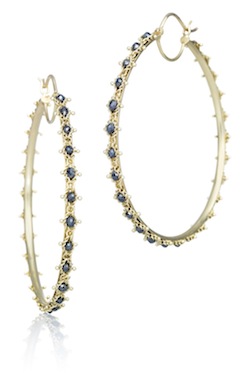
Above left: 18k yellow gold earrings with black diamonds and emeralds, by Pamela Huizenga; right, 18k gold and black diamond hoops by Amali. Below, Syna's "Bauble" collection in 18k gold with gemstones is casual, stackable, and still precious.
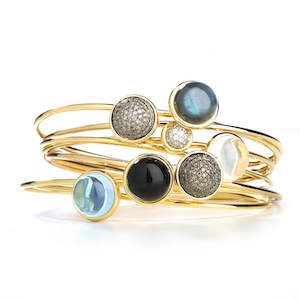
And, finally, even more new competition, says Elizabeth Anne Bonnano, Jewelry Historian and Luxury Branding Expert:
I think The Next Big Thing in the luxury jewelry market is more galleries and boutiques—not jewelry stores—selling high-end jewelry. I spent an evening with Jennifer McCurry of Marissa Collections in Naples, FL, this past June. The “mini-Bergdorf Goodman” the MC team has so perfectly vetted is magical. The jewelry department, Jay Hartington co-owner noted, is a gallery, not a department.
While shopping for a summer frock, shoes, handbags, and spectacular jewelry also came pouring into the private dressing room, along with libations and treats. I left having had an experience. It was personal and it was luxury.
Other similar boutiques are Ikram in Chicago, Capitol Charlotte in North Carolina, A’ Maree’s in Newport Beach, CA, and Seaside Luxe. This renewed business model is challenging not only our larger department stores but it is certainly giving the more traditional jewelry stores a run for their money. If you think that this is “nothing new,” I beg to differ. Many of these stores are actually buying from their designers because they are BUYERS. I find that these stores are staying ahead of the client and gently guiding them to understand the new developments and designers in the jewelry world. They buy very important pieces that might not sell immediately because they know it will draw the client to them. Eventually, they will be able to expand the thinking of their clientele and have them understand the artist. The small boutique seems to understand that what their clients want is a total experience, and what they offer to them must be unique. Who wants to see jewelry that travels from store to store when what they provide to their clientele can only be found in their door? This is the true art of selling. Many of these boutiques are also using http://www.farfetch.com as their e-commerce. This also allows buyers to find like venues all over the world. In my experience, even the largest, most luxurious retailers in the United States are losing their luxury edge because they are being directed by a corporate mandate.
Gen Y’ers and the older generation have more in common than you’d think. They’re looking for an experience. They do not care what you do; they care why you do it! Marissa Collections is a beautiful store with one of the most comprehensive jewelry collections I’ve ever seen in a “boutique” setting, but they are not intimidating. Walking into the store is inviting and welcoming. Jewelry stores often create, for understandable reasons, an atmosphere that screams, “stay out!”
Of course, traditional bridal will still be found in the more traditional doors, and I am most certainly not saying that there are not spectacular jewelry stores in the US that serve up luxury and experience on a silver platter—but what I’m saying is, watch out! There’s new competition.







